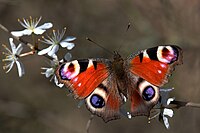
Effects of physiological integration on defense strategies against herbivory by the clonal plant Alternanthera philoxeroides
Sign Up to like & getrecommendations! Published in 2019 at "Journal of Plant Ecology"
DOI: 10.1093/jpe/rtz004
Abstract: The plant–herbivore interaction is one of the most fundamental interactions in nature. Plants are sessile organisms, and consequently rely on particular strategies to avoid or reduce the negative impact of herbivory. Here, we aimed to… read more here.
Keywords: defense strategies; plant alternanthera; defense; physiological integration ... See more keywords

Physiological integration between Bermudagrass ramets improves overall salt resistance under heterogeneous salt stress.
Sign Up to like & getrecommendations! Published in 2022 at "Physiologia plantarum"
DOI: 10.1111/ppl.13655
Abstract: Connected ramets of colonal plants often suffer from different environmental conditions such as light, nutrient and stress. Colonal Bermudagrass (Cynodon dactylon (L.) Pers.) can form interconnected ramets and this connection facilitates the tolerance to abiotic… read more here.
Keywords: physiological integration; salt stress; bermudagrass; salt ... See more keywords

The Intensity of Simulated Grazing Modifies Costs and Benefits of Physiological Integration in a Rhizomatous Clonal Plant
Sign Up to like & getrecommendations! Published in 2020 at "International Journal of Environmental Research and Public Health"
DOI: 10.3390/ijerph17082724
Abstract: Clonal plants in grasslands are special species with physiological integration which can enhance their ability to tolerate herbivory stress especially in heterogeneous environments. However, little is known about how grazing intensity affects the trade-off between… read more here.
Keywords: simulated grazing; integration; intensity; physiological integration ... See more keywords

Intra-colonial diversity in the scleractinian coral, Acropora millepora: identifying the nutritional gradients underlying physiological integration and compartmentalised functioning
Sign Up to like & getrecommendations! Published in 2018 at "PeerJ"
DOI: 10.7717/peerj.4239
Abstract: Scleractinian corals are colonial organisms comprising multiple physiologically integrated polyps and branches. Colonialism in corals is highly beneficial, and allows a single colony to undergo several life processes at once through physiological integration and compartmentalised… read more here.
Keywords: colony; intra colonial; edge; integration compartmentalised ... See more keywords